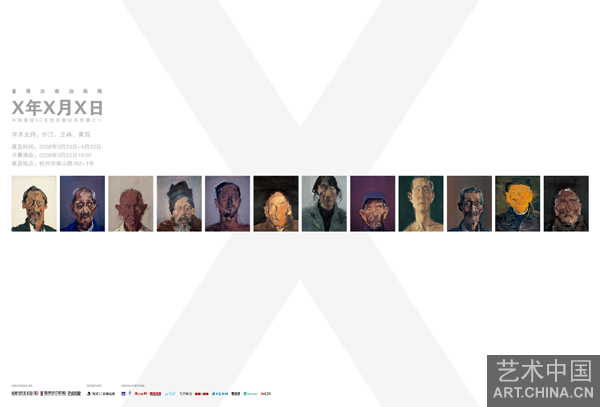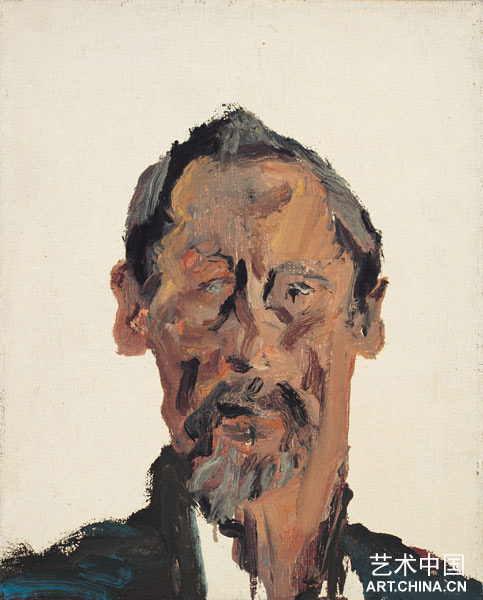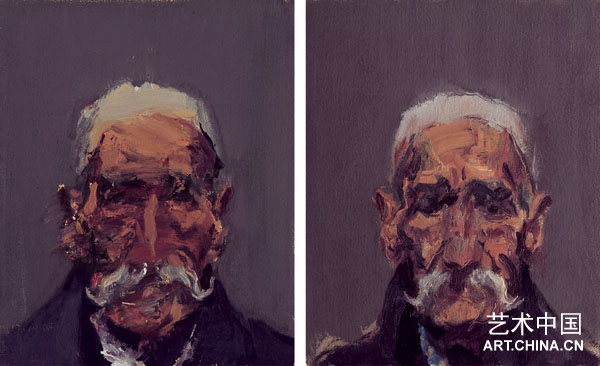
X年X月X日—童雁汝南油畫展
中國美院80年校慶期間系列展之一
主辦單位:杭州當代美術館(籌)、雁南藝術機構、《藝術名家》雜誌
學術支援:許江、王林、黃篤
展覽地點:杭州市南山路182-1號
開幕酒會:2008年3月23日19:00
展覽時間:2008年3月23日—4月22日
評 論
當我們面對這一群群無聲息的、糾結著滄桑的筆觸、渾然的影調的肖像之時,我們同時所面對的是童雁式的觀看,或者説是那種漫遊中的心靈。我們並不努力地看清那人,而是去捕捉那種尚在混沌之中的狀態。我們並不刻意追求視覺焦距的明晰,而是去琢磨心思相遇相渾的瞬間。這狀態和瞬間常常疊映而為渾茫的丘壑,如雲山、夜山、雨山一般,寂然一片。那面龐臉形變為丘壑之時,也如丘壑一般沉默無語,化作整體的意態沉吟。五官陷入溝壑之中,細節讓位給了影壁一般的歲月流痕。這生成的主角常常是我們自己,是我們如此這般地趕在清晰地“看見”之前,把握到的朦朧的“所看”。正是這種“所看”引領著我們捕捉生活的瞬間,體驗那不經意的留意,守候不期而然的確然。我們仿佛被帶到那個觀看的現場,品賞某個觀看生成的瞬間,在猝不及防之時,肖像背後的隱語正被看見,面龐丘壑的沉吟正被聆聽。當我們對這種丘壑有所感悟之時,我們也正領受某種觀看的詩學。(《南山、丘壑與漫遊》節選 )
許 江 2007年8月16日 西湖南山三窗閣
Therefore, as we are facing the crowds of silent figures entangled with brushstrokes full of vicissitudes and integrated tinge, we are at the same time facing the watching of Tong Yan’s type, or facing a kind of souls in rambling.
We do not distinguish those figures with great effort, whereas we try to catch the kind of state still in chaos. We do not pursue the perspicuity in visual focus, whereas we ponder over the moments of the meeting and the merging of thoughts. Such states and moments often overlap and reflect with each other, turning into integrated hills and gullies, and forming a whole silence, as cloudy hills, evening hills, or rainy hills.
When the shape of faces turn into hills and gullies, they, also, are silent like hills and gullies, muttering as an meaningful integrated appearance. The facial features fall into the gullies, while the details give way of marks of time, looked like a worn screen wall.
The prompters of such turnings are no other than ourselves. It is ourselves rushing through to grasp the vague seen before we see clearly. It is just about this kind of seen that leads us to catch the moments in life, to experience the careless care, and to wait for the uncertain certainty.
It seems that we are taken to that spot of watching, to appreciate a certain turning-watching moment. At an unexpected moment, the riddle behind the figures is being caught, and the muttering of the figures or those hills and gullies are being listened. When we feel something from this kind of hills and gullies, to some extent, we are receiving a certain poetics of watching. (《The South Hill, Gullies and Rambling》digest)
Xu Jiang August 16, 2007 In the Pavilion of Three Windows, South Hill, West Lake, Hangzhou
在童雁汝南的巨制鴻篇《滿覺隴的同志們》中,這些胸像都以單色背景畫出,略有變化但整體協調,灰色的作用使色彩中性化,這對組合性作品是必需的形式要求。人物各具情態,因隨意而鬆動,因書寫而自由。畫家在不經意間對於對象特徵的把握是十分準確的。為一座村莊的“同志們”寫生,不僅有社會學考察的意義,還有點向肖像畫難度挑戰的意圖。這些頭像排列在一起,成為中國人物的方陣。當他們全都注視著你的時候,你會在目不暇接的觀賞狀態之中,感覺到一種異樣的視覺挑釁和心理緊張。我想這正是畫家期望達到的現場效果。(《繪畫的詩學與人的主體性——對童雁汝南作品的個人閱讀》節選)
王 林 2007年8月28日 四川美院桃花山側
These busts of Tong Yan Ru nan’s huge painting Comrades in Manjuelong are all drawn out of the monochromatic background, in a harmonious integration with slightly change, in which the function of the grey makes the color neutral. This is an essential requested form for a painting series. The figures with various looks become flexible for the liberal disposal, and become free for writing. The painter's inadvertent assurance to the subject's characteristic is very accurate. Sketching for comrades of a whole village does not merely have the significance of sociological investigation, but an intention of challenging the difficulty degree of the portrait painting. Those figures are arranged together, becoming the square matrix of Chinese folks. When they are all gazing at you, you will be feel a kind of unusual visual provocation and the psychological tense, in the state of appreciating too plenty for the eye to take it all in. I think this is exactly an on-the-spot effect that the painter expects to give us.(《Poetics of Painting & Human’s Subjectivity --Personal reading of Tong Yan Ru Nan's works 》digest)
Wang Lin August 28, 2007 Peach-Blossom Hillside, Art Institute of Sichuan
我知道汝南是希望與古典主義告別的年輕藝術家,所以就産生了另外一個疑點,在他藝術表現遠于傳統近於當代時,我們卻無法在藝術家的個人內心狀態中獲得解釋,因此描述汝南的藝術就不那麼容易。
一般來説,對汝南的作品關注都會側重他的頭像系列,如果説面孔是認識人的內心深處的窗口,那麼他把肖像的面孔處理成模糊的似是而非的形象,這樣認識人心靈的窗戶就變得曖昧。然而,這種效果是靠什麼來完成呢?藝術家通過流動性、隨意性、偶然性渾厚而粗獷的寫意方式實現的形象特徵,以此把明確而具體的意義變成了想像和抽象的圖像。也就是説,把身邊作為個體人的特徵轉變成了普遍意義人的特徵。(《童雁汝南:從經典美學轉机譯的繪畫當代性》節選)
黃 篤 8月29日于北京
I know that Runan, as a young artist, hope to depart classicalism, thus comes the other doubtful point: if his artistic expression is as far as tradition and as new as the present age, why cannot we find the proper interpretation in his inner world? So it is somewhat difficult to describe Runan's art.
Generally speaking, attentions paid to Runan's works often emphasized particularly to his head portrait series. If the face was the window to look into the dim recess of one's mind, in the delusively blurry images of his portraits, the window to read one's heart became ambiguous. But how could he create such effects? By forming the character with fluidness and uncertainty and in a haphazard and straightforwardly impressionistic way, the artist transformed concrete and specific meanings into imaginary and abstract images. In other words, individual characteristics were converted into universal meaning of human life.(《Tong Yan Runan: Contemporary Painting Translated from Classical Aesthetics》digest)
Huang Du August 29, 2007 Beijing
簡歷
童雁汝南:杭州當代美術館(籌)館長、《藝術.名家》雜誌藝術總監、中國美協會員、浙江雕塑研究會副會長、多家藝術基金顧問、中國美院講師。現居北京杭州。1990銀帆獎;1999李仲生藝術獎;2000崇麗藝術獎;2001中國油畫大展獲銅獎、中國藝術大展獲金獎;2003中國油畫大展、法中文化年展;2004十屆美展、優秀青年藝術家提名獎;2005浙江油畫大展獲金獎;2006中國傑出中青年室內建築師、“匙”菲律賓國家博物館•大都會博物館、國家重大歷史題材美術創作工程、香港osage個展、浙江美術年獲學術獎、今日中國美術大展、全國城雕優秀獎;2007北京TRA個展、創意中國盛典最具創意産品獎提名;2008北京國際雙年展。


|

